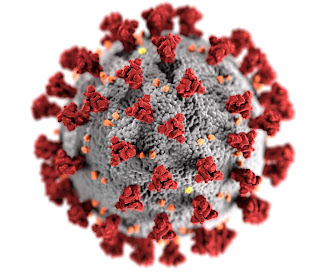 |
| SARS-CoV-2 virus. Credit: Alissa Eckert, Dan Higgins CDC PHIL ID#23312 |
In Past Pandemics I noted that COVID-19 and influenza are caused by viruses, while the Black Death was caused by bacteria. What are the differences between viruses and bacteria? Let's review some basic biology.
Two types of large, complex molecules are found in both viruses and bacteria:
- genetic material
- proteins
A bacterium is a wonderfully complex thing. It contains not only genetic material and proteins, but also: the molecular machinery for making more genetic material and proteins; the raw materials for making more genetic material and proteins; and other stuff that is outside the scope of this post.
The molecular machinery is itself made of proteins and genetic material, which as noted above are large, complex molecules. The raw materials are smaller, simpler molecules that can be assembled by the molecular machinery into more complex molecules.
A bacterium is a cell. Cells consist of cytoplasm enclosed in a membrane. The genetic material, the proteins, the raw materials, and the molecular machinery all float around in the cytoplasm.
A virus is less than a cell, and therefore smaller and simpler than a bacterium. A virus consists of genetic material surrounded by proteins. That's it. There is no molecular machinery for making more genetic material or proteins. There are no raw materials for making more genetic material or proteins. There is nothing floating around in cytoplasm because there is no cytoplasm.
The parts of a bacterium are dynamic. Things move around. The machinery works. A bacterium is abuzz with activity at the molecular level much of the time. In contrast, a viral particle by itself is static, inert.
A bacterium is sufficiently complex that it can reproduce itself through a process called cell division. A virus cannot reproduce itself. Viruses replicate by invading a cell and hijacking the molecular machinery and raw materials of that cell to create new viral particles. Viral diseases are caused by this invasion of host cells and the release of hordes of new viral particles that then invade more cells.
Are viruses alive? That depends on who you ask and their definition of life. Viruses are not as fully alive as bacteria because they cannot (on their own) manufacture proteins or genetic material, and they cannot self-reproduce.
Both viruses and bacteria come in many shapes and sizes, but viruses are generally much smaller than bacteria. The image at the top of this post is a computer-generated illustration of the SARS-CoV-2 virus that causes the COVID-19 disease. (source) (See The Spiky Blob Seen Around the World for an interesting New York Times article about this illustration.)
The SARS-CoV-2 virus is roughly spherical with a typical diameter of 100 nanometers. In comparison, E. coli is a common bacteria that is rod-shaped with a typical length of 2,000 nanometers and a typical diameter of 500 nanometers. See the scanning electron micrograph below (2 micrometers = 2,000 nanometers):
 |
| E. coli bacteria. Credit: NIAID |
Not all bacteria are harmful. Many kinds of bacteria are beneficial. For example, a complex ecosystem of gut bacteria in humans (including some types of E. coli) is essential for processing food. On the other hand, all viruses are considered pathogens (disease-causing agents) although only a small percentage of viruses infect humans. Viruses can infect many living organisms, including bacteria. Viruses that infect bacteria are called bacteriophages or simply phages.
Our bodies have many natural defenses against the viruses and bacteria that are human pathogens. We get sick when those defenses fail. (We can also get sick if those defenses overreact, but that topic is beyond the scope of this post.) What does modern medicine have to offer when our natural defenses against pathogens fail?
Because bacteria are more complicated than viruses, there are more ways to attack them. There are many antibacterial drugs, called antibiotics. Penicillin is an antibiotic that kills bacterial cells by attacking the cell wall – a structure present in most bacteria cells, but not in animal cells.
Viruses are simpler than bacteria, and aren't as fully alive, so they are more difficult to "kill." It is not possible, for example, to inactivate a virus by attacking the cell wall, because there is no cell wall. A small number of antiviral drugs exist for a limited number of viruses, but none yet for SARS-CoV-2. Multiple groups of scientists are working on such drugs.
Some viral diseases (and some bacterial diseases) can be prevented (not cured) with vaccines. That subject is outside the scope of this post except to note that no vaccine currently exists for COVID-19. As with antiviral drugs, multiple groups of scientists are working to develop a vaccine.
The common cold is typical of human experience with viral diseases. Humans all over the world would dearly love to find a cure or vaccine for the common cold, which is caused by viruses. But no cures or successful vaccines have been developed. The best we can do is take medicines that alleviate some of the symptoms while the body slowly cures itself if it can.
There is much more to viruses and bacteria, of course. If you are interested in learning more, follow the links in the previous sentence to get started.
A few things to remember from this basic introduction:
- A bacterium is a cell. A virus is less than a cell.
- Viruses replicate by invading a host cell and hijacking its machinery to make more viral particles.
- Antibiotics only work on bacteria. Antibiotics do not work on viruses.
No comments:
Post a Comment